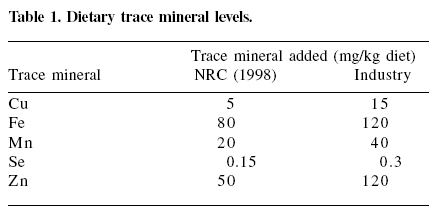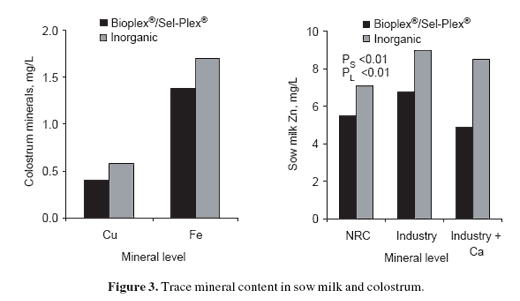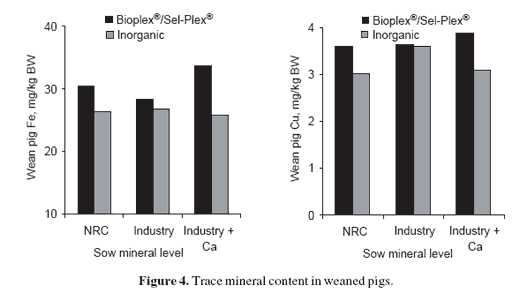organic trace minerals in swine nutrition
Enhancing sow reproductive performance by organic trace mineral (Bioplex® and Sel-Plex®) dietary inclusion
The efficacy of organic trace minerals in swine nutrition has not been adequately evaluated, particularly during the reproductive period. However, the research to date has generally used a combination of inorganic and organic mineral mixtures. This procedure does not evaluate either source independently and may be confounded further because both inorganic and organic trace minerals may be found in several forms.
The bioavailability of each is influenced not only by its form but the ionic state of the other minerals provided in the diet. Some minerals are tightly bound in the grain protein matrix requiring enzyme(s) to hydrolyze the chemical bond, others may be bound loosely to amino acids or proteins that are easily degraded in the intestinal tract, while inorganic minerals may chelate with other minerals in the intestinal tract.
When additional calcium (Ca) is added to the sow’s diet, its addition may sequester other macro- and microminerals making them less available for absorption. Consequently, the bioavailabilities of the different forms of the organic trace minerals are also still uncertain, and probably differ by animal species. Therefore, because of these changing relationships the study of mineral nutrition is probably one of the more complex areas of animal nutrition.
The essential microminerals, copper (Cu), iron (Fe), manganese (Mn), selenium (Se) and zinc (Zn) have typically been added to most swine diets in the inorganic salt form and generally at dietary levels exceeding NRC (1998) recommendations. Higher dietary inclusion levels have generally assumed that the biological availability of the indigenous minerals found in grains is not known and that with the high production capability of the modern maternal sow lines, additional minerals are needed to meet the sow’s greater nutritional demands.
Supplementation of essential trace minerals to sow diets has shown favorable responses. Mirando et al. (1993) reported that when they replaced a portion of the inorganic minerals with an organic source in a sow herd that was experiencing low productivity, they achieved more live pigs born. Other research has demonstrated fewer days to reach puberty, and a greater concentration of the essential trace minerals in the conceptus products by 12 to 15 days postcoitum when an organic form was used (Hostetler and Mirando, 1998).
Spears et al. (1995) reported that when a portion of the inorganic trace minerals was replaced by organic mineral proteinates, there was a trend toward heavier litter weights, and a reduction in the wean-to-estrus interval. Flowers et al. (2001) reported a greater number of pigs born when inorganic trace mineral levels were provided at levels below NRC (1998), suggesting detrimental effects when inorganic minerals are fed in excess.
Although high pharmacological dietary levels of copper and zinc have been used effectively in pig diets, their effects are probably through enhanced gut morphology and in controlling the gut microbiota. The same antibacterial effect can be seen where sow diets supplemented with 250 ppm Cu sulfate resulted in a greater number of pigs born and heavier pig weaning weights over a six-parity period compared to a diet with 9 ppm Cu (Cromwell et al., 1993). The integrity of the intestinal epithelium was greater along with a better immune capability in nursing pigs when sows were fed pharmacological levels of an organic zinc amino acid complex (Caine et al., (2001).
The role of selenium and how the body absorbs and uses this element differs markedly from the other organic trace mineral sources. The evidence is now clear that organic selenium in the form of Sel-Plex® selenium yeast not only enhances body tissue selenium stores in the sow and fetus, but it also increases the colostrum and milk selenium concentrations and the selenium status of the pig at weaning (Mahan and Peters, 2004). This is largely due to the fact that the selenium is within the protein chain as the amino acid selenomethionine, and not chelated or bound to an amino acid or hydrolyzed protein molecule as are the other trace minerals.
Collectively, these reports suggest that 1) dietary organic mineral may have a positive role in sow reproductive performance, and that 2) inorganic mineral when fed in excess may be detrimental to sow reproduction. This was examined at our station in a sow experiment for a six-parity period.
Experimental methods
The experiment was conducted by feeding one of four diets from 30 kg to breeding using inorganic and organic trace mineral sources. The dietary levels evaluated are presented in Table 1 and were: 1) NRC levels of Cu, Fe, Zn, Mn, and Se (NRC); 2) High levels of these trace minerals at dietary levels suggested by feed industry and university specialists (IND).
The trace minerals were added either in the inorganic form or from the organic complex using the Bioplex® and Sel-Plex® products (Alltech Inc., Nicholasville, KY). At breeding two additional treatments with added calcium and phosphorus (P) were provided to the treatment list, but only added to those diets containing the industry-recommended trace mineral levels (IND + Ca). These latter two diet combinations were added because of the projected depletion of Ca and P that has been reported to occur with the high productivity of modern sow lines. 
The sows used were continued for a six-parity period, but some were killed at periodic intervals (i.e., weaning) to determine body mineral composition at parities 1, 2, 4, and 6. In addition, sows were milked each parity on 0 day (colostrum) and at weaning (17 days postpartum). Stillborn pigs of full term and of a normal birth weight were collected, weighed, and analyzed for mineral content. The data were analyzed by SAS but only a portion of the data will be reported here.
Results and discussion
The effect of the various treatments on resulting sow reproductive performance over the six-parity period is presented in Figure 1. Overall, the reproductive performance of the sow herd was considered excellent with an average litter size exceeding 11 pigs born live. We cannot provide the longevity of the sows for the various treatments because several animals were killed at periodic intervals for body composition analysis and thus were not able to be evaluated for the entire length of the study. As noted in Figure 1 there was a total of 375 litters over the six-parity period with each bar representing approximately 60 litters. 
The data in Figure 1 demonstrate that feeding organic minerals (Bioplex®+ Sel-Plex®) in the gestation and lactation diets resulted in one additional pig (P<0.05) born (total) per litter when both the NRC and IND levels of this mineral mixture were provided. In contrast, when inorganic trace minerals were fed, reproductive performance was lower within each treatment comparison, but higher when the NRC level was provided. There was an apparent decline in reproductive performance with increased level of inorganic trace minerals, in both total pigs per litter (P<0.09) and live pigs per litter (P<0.05). This suggests that when dietary inorganic trace mineral levels are perhaps in excess there is a reduction of reproductive performance of sows, a response similar to that reported by Flowers et al. (2001).
It was of great interest to note that when additional Ca and P were added to the diets, litter size declined further when either the organic or inorganic minerals were provided, but the effect was more pronounced with the inorganic mineral treatment group. This suggests that the addition of Ca to the sow diet may have been responsible in lowering reproductive performance of the sow, but the reasons are at the moment unclear.
It is also of interest that within each treatment group, sows given the organic trace minerals had the greater number of pigs born. Apparently, utilization of either source of minerals does not differ once absorbed from the intestinal tract. Consequently, the main role of organic minerals may be in the mechanism of their absorption or in their ionic state during the digestive or absorption process. This is presently under investigation.
The mineral content in the neonatal pig for two of the minerals for both mineral forms at the various levels when fed to the sow is presented in Figure 2. Although all microminerals show the same general trend, the content of iron and copper in the neonate did not appear to differ between mineral sources and at the various dietary levels provided to the sow. This suggests that the fetal pig has a defined priority for mineral retention from the maternal blood supply and that these and other trace minerals retained by the fetus will be met either from the sow diet or from sow tissue reservoirs. 
Sow colostrum and mature milk at weaning contents of selected trace minerals are presented in Figure 3. In all cases, colostrum trace minerals tended to be greater when the inorganic trace minerals were fed to the sow, but the differences were not significant. The examples presented in Figure 3 show the concentrations of iron and copper in sow colostrum. In mature milk there was an increase in mineral concentrations when the dietary level fed to the sow was increased, and again the inorganic mineral levels had the greater concentrations as the levels increased (P<0.01).
Trace minerals retained in the tissue of the weaned pig are presented in Figure 4. Although there was a significant effect on the milk mineral contents, such was not the case when total body composition of the weaned pig was evaluated. The weaned pig seemed to have greater concentrations of iron and copper when the organic trace minerals were fed, but the differences were not significant. In addition, as the dietary level fed to the sow increased, the mineral contents did not increase, suggesting that retention of these trace minerals by the pig may be regulated. 

Sow liver mineral content at the time of weaning is presented in Figure 5. The liver tissue is the most labile tissue for trace mineral mobilization, and should reflect the changing status of the sow’s mineral reserves. The results for iron and zinc generally show the same response for either trace mineral source. Although there is a trend for an increase when the higher level (IND + Ca) diet was fed, the results are not consistent.
Conclusion
The use of organic trace minerals in sow reproductive diets certainly deserves further investigation. Our results consistently show a reproductive advantage when the organic trace minerals are incorporated into the sow’s diet. It would appear that feeding dietary levels in excess of NRC (1998) would enhance reproductive performance, but only when organic trace minerals are fed.
The results of this study and those of Flowers et al. (2001) suggest that inorganic minerals fed in excess may result in detrimental effects on sow reproductive performance. The developing fetus evidently has a tremendous capability to use the absorbed minerals, concentrating them in well defined amounts and ratios within developing body tissue. Thus, tissue reserves in the neonate as well as the weaned pig do not reflect differences between the various dietary levels in the sow’s diet. Overall, it would appear that organic minerals have a role in swine production, but that the mechanisms for absorption and utilization by the sow and fetus are at the present unclear.
References
Caine, W., M. McFall, B. Miller, C. Onderka, R. Kirkwood, S. Jaikaran and T. Fakler. 2001. Intestinal development of pigs from sows fed a zinc amino acid complex. Banff Pork Seminar Proceedings. Advances in Pork Production 12:Abstr. No. 15.
Cromwell, G.L., H.J. Monegue and T.S. Stahly. 1993. Long-term effects of feeding a high copper diet to sows during gestation and lactation. J. Anim. Sci. 71:2996-3002.
Flowers, W.L., J.W. Spears and G.M. Hill. 2001. Effect of reduced dietary Cu, Zn, Fe, and Mn on reproductive performance of sows. J. Anim. Sci. 79(Suppl. 2):61.
Hostetler, C.E. and M.A. Mirando. 1998. Dietary supplementation of proteinated trace minerals influences reproductive and growth performance of gilts. J. Anim. Sci. 76(Suppl. 1):274.
Mahan, D.C. and J.C. Peters. 2004. Long-term effects of dietary organic and inorganic selenium sources and levels on reproducing sows and their progeny. J. Anim. Sci. 82:1343-1358.
Mirando, M.A., D.N. Peters, C.E. Hostetler, W.C. Becker, S.S. Whiteaker and R.E. Rompala. 1993. Dietary supplementation of proteinated minerals influences reproductive performance of sows. J. Anim. Sci. 71(Suppl. 1):180.
NRC. 1998. Nutrient Requirements of Swine, 10th ed. Nat’l Acad. Press, Washington, D.C.
Spears, J.W., W.L. Flowers, E. van Heugten and E.B. Kegley. 1995. Effect of metal proteinates on baby pig growth and survival and sow reproductive performance. NCSU Animal Science Ann. Report.
Authors: D.C. MAHAN and J.C. PETERS
Department of Animal Sciences, The Ohio State University, Columbus, Ohio, USA







